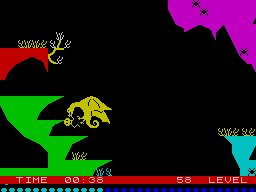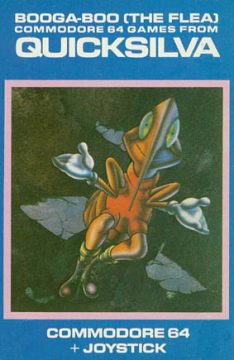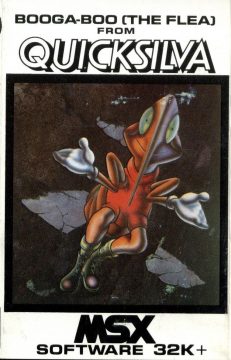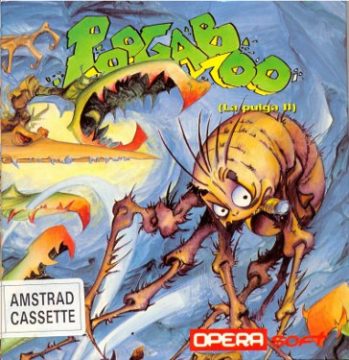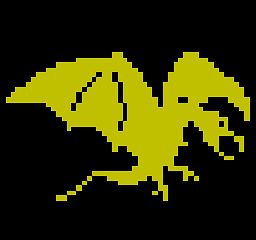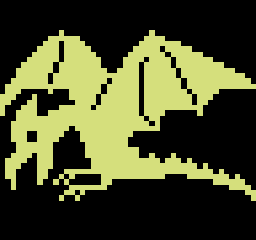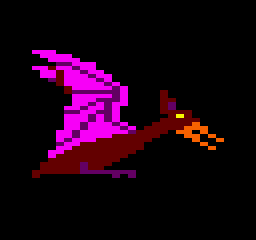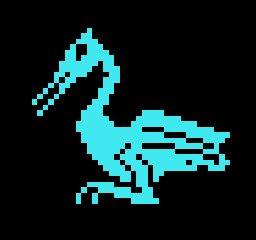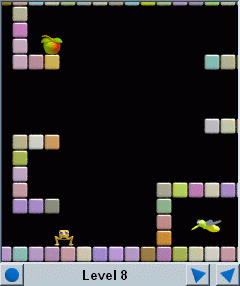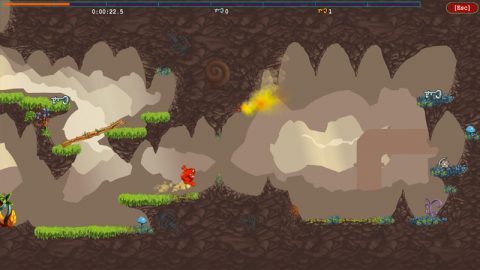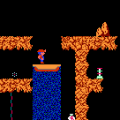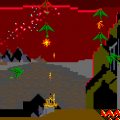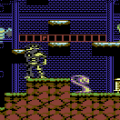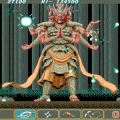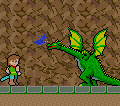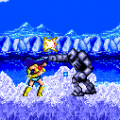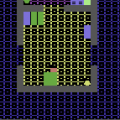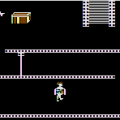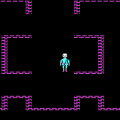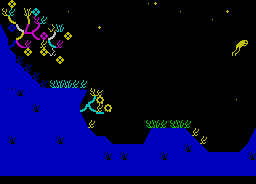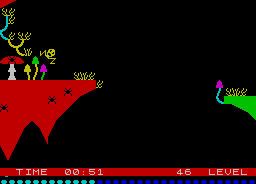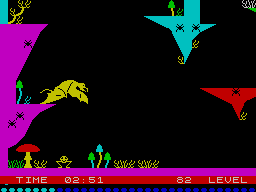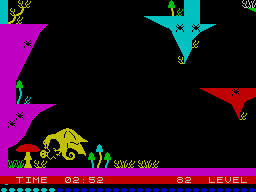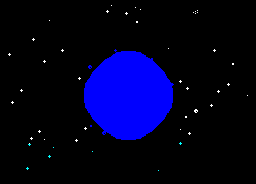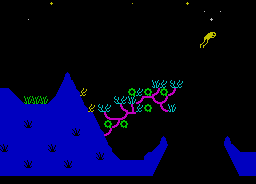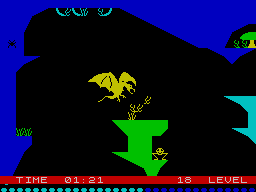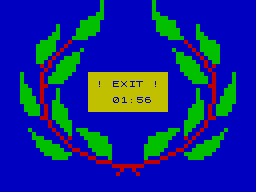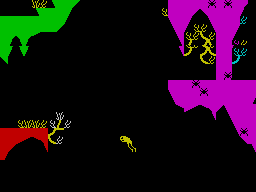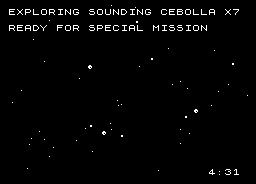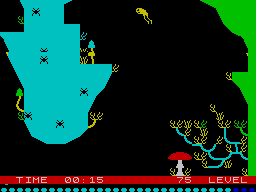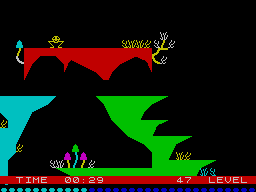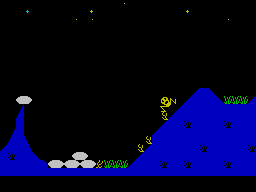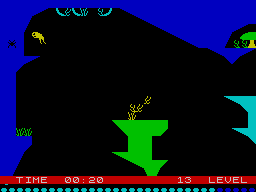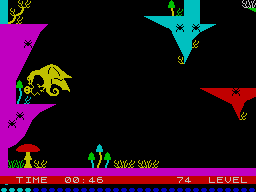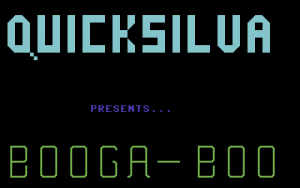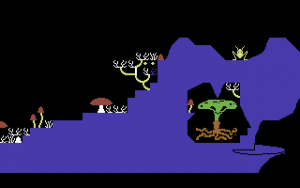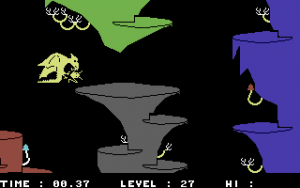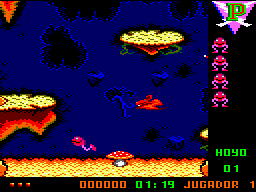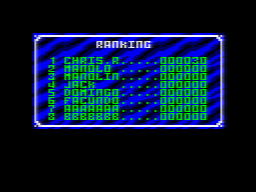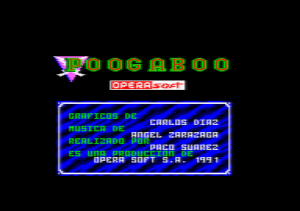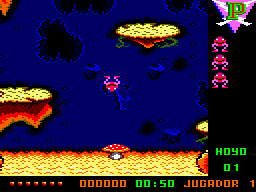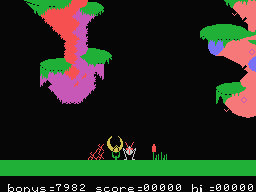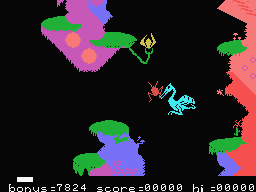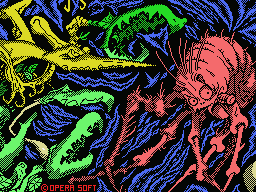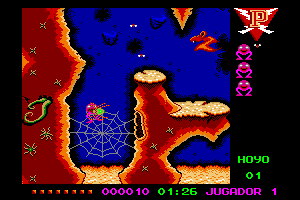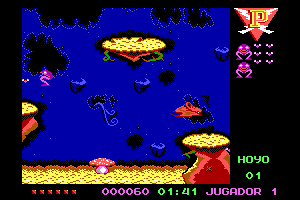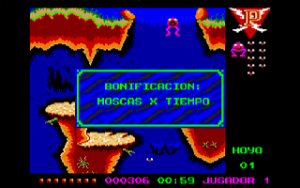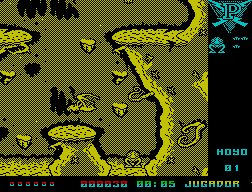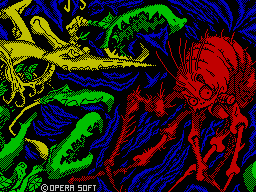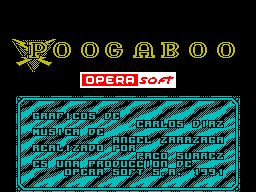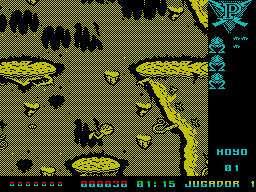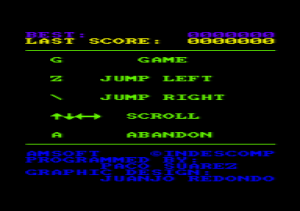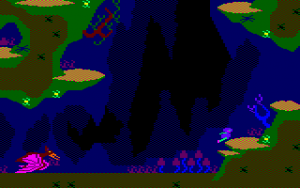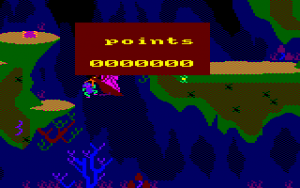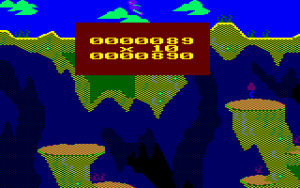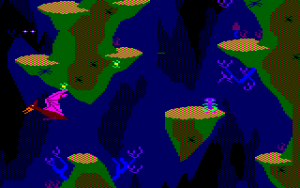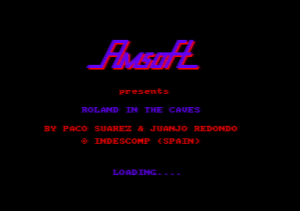Francisco Portalo Calero, better known to gamers as Paco Portalo, and others have written extensively about both Bugaboo (The Flea) and the new epoch of Spanish game development which followed its release. But despite early 80s Spain housing many of the world’s most prolific developers of 8-bit computer games, this part of video game history remains largely unspoken of outside of Western Europe. While video game sales suffered a major crash in North America in 1983 that the industry took three years to recover from, in Europe and Japan it was instead rapidly growing thanks to the quick spread of consumer level personal computers. Many of the genre structures and core concepts of how video games work that are taken for granted today took shape during this formative time. Bugaboo (The Flea), despite its very simple premise and singular enemy, is both unique and addictive thanks to the way in which the titular character navigates the game world.
First released in Spain in 1983 as La Pulga, the game was created by Paco Suárez and Paco Portalo while working for Jose Luis Dominguez’ Indescomp and originally published in the UK by Quicksilva. Soon after it was distributed in Spain itself by a fledgling Investrónica and was very popular in both countries. While it exceeded all expectations with its immediate popularity, the game actually had very humble origins. Paco Suárez originally designed La Pulgafor Sinclair’s ZX81 computer as a way to depict and observe parabolic trajectories (a result of his interest in astronomy). He sent this game along with an astrology suite written in BASIC to Indescomp. While this less realized version of La Pulga may seem primitive at a glance, its variety of levels and high jumping flea (depicted by a single asterisk here) is evocative of modern puzzle game hits like N+. According to a panel Suárez and Portalo spoke at for RetroEuskal 2010, Suárez was surprised to find that Indescomp discarded the latter submission but was extremely enthusiastic about publishing La Pulga as a standalone video game. However, by the time this was arranged Sinclair was already rolling out the ZX Spectrum, and so was it deemed appropriate to remake the game completely to take better advantage of the Spectrum’s capabilities. It was at this time that he began working with Paco Poltaro and the “Paco & Paco” partnership credited on Bugaboo‘s title screen began.
In just three months the two of them created an updated take on the game. Rather than keeping the multiple abstract puzzle areas of the original, Bugaboo is set in a single cavern from which the titular flea must escape. Its graphics may look simple today, but they are very well executed. A nice use of color, some inconveniently placed vegetation, and the angular, uninviting layout of the cavern itself foretells the alien, surreal landscapes that would come to define many later European platformers like Shadow of the Beast and Risky Woods. More information and imagery of that earlier incarnation of La Pulga can be found here, and while the Bugaboo we know on the Spectrum today only has one cavern instead of several, the artistic changes to the game are a huge step up.
The game also has a bit of a fun story attached to it, delivered both via the game’s cassette tape case liner notes as well as briefly in the game itself. The game, however, very importantly conveys this information in a much more original and groundbreaking way for a 1983 title. Taken together they raise a lot of questions aboutBugaboo‘s setting and titular character despite the simplicity of the game. The game’s UK notes give us a deliciously overwrought stream of consciousness from the world’s most egotistical flea:
Down through the inky spaces between worlds we fell, the ether whistling past.
Down, down into the blue, blue world below we fell landing easily on a shelf of rock.
Alien vegetation pointed colourfully upwards towards the stars from whence we came.
SPROING!
An alien world a million light years from home, and what strange life will we find here?
We sit and look ou tover the suns as they set in clouds of boiling vapors, the moons slowly gain dominance in the night sky.
SPROING! SPROING!
The Planet surface is cold now, we are going ot retire for the night, tomorrow we will explore.
Strange, we all feel as though we are being watched.
Silly really, new planets can do that to a person.
SPROING! SPROING! SPROING!
Now out jump I, BUGABOO! now gone they have; out BUGABOO!
From depths darkest, goes Hippity Hop I.
Up to the sky.
Almost I fly.
Now what think YOU, Of BUGABOO?
Caves and ledges, Caves and ledges: upto hop I, though I no fly, I am me.
BUGABOO and FLEA!! (You see).
BUGABOO we love you, BUGABOO love people too!
Bugaboo thinks pretty highly of itself, but we get a shorter yet more insightful take on events once the game is loaded up. Players are presented with a view of space, and a brief text message appears before an animation of their descent to a mysterious planet.
ZX Spectrum:
UNKNOWN PLANET DETECTED
ALMAT-1 SECTOR
4HA STATE
SEQUENCY SYSTEM ACTIVATED
EXPLORING SOUNDING CEBOLLA X7
READY FOR SPECIAL MISSION
Commodore 64:
UNKNOWN PLANET DETECTED IN SECTOR ALFA – 4
FORMS OF LIFE ARE DETECTED ON PLANET CEBOLLA – 7
WE GO TO EXPLORE THE PLANET WITH THE SOND PULGA-64
Hot take: It looks like Bugaboo was full of hot air and is actually an overly talkative biomechanical exploration tool used by an advanced society obsessed with flea-based mobility.
Bugaboo isn’t particularly good at its job unfortunately, as it quickly falls into a deep cavern. Escaping that cavern encompasses the entire game, and completing it can take anywhere from nineteen seconds to hours depending on the player’s mastery of Bugaboo’s movement. Bugaboo’s only way of getting around is to hop left or right. If one holds down the button, however, a meter at the bottom of the screen will begin to fill up, increasing both the distance and trajectory of its leaps. Good timing is required, as the cavern’s many ledges and alcoves require precisely calculated jumps to reach. If Bugaboo hits its head on a wall, it immediately stumbles and falls back to the ground.
Fortunately, players will know all of this information even without instructions, as Bugaboo is one of the earliest games to have an in-game cutscene as part of its introduction. During it we see Bugaboo hopping around on the hilly mound surrounding the cavern it eventually falls into. More than just a show, it also offers a concise lesson on the different angles Bugaboo can jump at as well as the amount of leeway allowed for reaching the edge of or jumping over the many precipes encountered underground. That the video game is challenging while still being simple enough that it can be explained without words in a few seconds is a balance many games still struggle with today, a very rare accomplishment. Bugaboo has one more trick up its sleeve. The high speed, high jumping action seems like it would make for lots of blind leaps off screen into the unknown, frustrating players as aimlessly jumping past the edge of the screen tends to do in platformers. In this game, however, players are allowed to scroll the screen in any direction around Bugaboo, allowing for a nice level of planning to help master the game’s many alcoves and corners. This level of control and ability to scope out parts of the game world before acting was a huge deal in 1983, and became commonplace in platforming games made in the late 80s and early 90s like Super Mario World and Sonic the Hedgehog.
Bugaboo (The Flea) was an immediate hit in both the UK and Spain, getting great reviews based on both its challenge and graphics, with a review in Computer and Video Games heavily praising its graphics, unique style, and challenge as “… a fresh and original approach to game design have been combined to produce yet another top rate game.” Bugaboo got so big that it was even briefly released in the US along with Sinclair and Timex’s shortlived attempt to bring the Spectrum computer to North America. The game was then converted for the Commodore 64 and the Amstrad CPC in Europe. Both were developed by Indescomp via Jose Luis Dominguez. The Commodore 64 conversion was programmed by Pedro Ruiz. Felix Arribas provides some music for the game as well. Angel Dominguez, Juan Manuel, and Jose Maria Tips contributed to its production also. Now renamed Booga-Boo (The Flea), the Commodore 64 version looks like the exact same game with new art and a new color palette but actually has some major changes. There are some nice new details like eyes peering out from the cavern’s many corners, but also the addition of two giant plants at the bottom corners of the labyrinth that will instantly consume the newly named Booga-Boo if it lands on them. The music, Felix Arribas’ only game development credit, is serviceable but doesn’t particularly stand out, and will become grating after extended play sessions. Still, the redrawn cavern has a similar, but unique style compared to the original. Booga-Boo also actually looks more like a flee on the Commodore 64 instead of the more surreal smiley face with legs Paco & Paco created, though the latter is a good fit for the game’s bizarrely colored alien world.
The Amstrad CPC version got a more drastic visual make over, as publisher Amsoft chose to have the game become another installment in a series of Roland (a recurring mascot character named after CPC lead designer Roland Perry) titles. Now known as Roland in the Caves, in this appearance Roland takes the shape of an odd blue gingerbread man (Roland assumes many forms, as most of his other games are conversions of popular titles as well) . We get treated to a rendering of La Cucaracha over the game’s menu, but the opening and introductory scenes are completely gone, with Roland immediately plummeting into the cavern when the game starts. The graphics have been given a complete overhaul, made to look more earthly compared to the landscapes on the ZX Spectrum and Commodore 64. They’re a bit muddy but not particularly bad. Those two giant plants from the Commodre 64 version are gone as well, but in their place are a few small pits filled with many tiny carniverous plants, which can be even more frustrating. Despite the increased challenge and loss of the intruiging introduction, it’s a good conversion of a unique game programmed by Paco Suárez himself with graphics courtesy of Juanjo Redondo.
Bugaboo fairs pretty well on the MSX too, and is still fun. It’s redundatly retitled La Pulga (Bugaboo) on the game’s box, but the title screen gives us the name Booga-Boo, and remains the sole game design work of Ann and Steve Haigh. This MSX release, like other conversions, offers a slightly different maze layout, and yet another new arrangement of carniverous plants to avoid. Bugaboo himself resembles a flea again rather than the bizarre Roland redesign chosen for the Amstrad CPC conversion. There are two changes to the game’s interface as well. Instead of seeing a timer at the bottom of the screen a “bonus” value that counts down like in Donkey Kong is shown instead so players will be readily aware of how well they’re doing. The really nice change, however, is that the gauge that charges up as player’s hold down a jump button is represented by a smoothly increasing bar instead of individual segments. This makes it much easier to gauge a precise angle for each jump.
No matter which version of Bugaboo someone plays, however, sooner or later they’re going to have a run in with one of these hungry fellows:
It’s a good thing the “SOND PULGA-64” was deployed to explore this strange world instead of human beings (no offense Roland), since that life form reading has turned out to be a huge dragon (or a pteranodon depending on the player’s computer of choice). This dragon is the game’s sole enemy, and will fly around randomly until it gets near Bugaboo. At this point the player needs to forget about escaping the cavern and worry about getting far enough away from the dragon to lose its attention for a bit. If the dragon reaches the player, Bugaboo is instantly consumed and the game must be restarted.
In an act of extreme cruelty, the Commodore 64 version of the game begins with Bugaboo near a very direct path out of the cavern. However, the game also always places the dragon near the cavern exit, meaning that rushing right up this easy path will usually result in a quick death. While the monster is also a bit more aggressive in the MSX port, the Amstrad CPC release has it at its most ruthless. As soon as you begin playing Roland in the Caves the creature is already flying straight towards poor Roland, giving players almost no time to plan their first few jumps. This is a huge change compared to the game on the other three systems where players will generally have some time before they see the creature.
Having a single enemy trying to zone in on the player throughout the game is great, it navigates the game’s cavern slowly, meaning there’s a fair chance of getting some breathing room from it. At the same time, it’s always effectively just around the corner, as players will need to scroll the screen around regularly to plan out their next jump. It has the inadvertant effect of adding some jump scare (literally given the how the main character moves) moments to the game, as players can be lulled into a false sense of security by not seeing the creature at all for a minute or two before realizing it’s lurking directly next to them just a bit off the edge of the screen.
While Bugaboo (The Flea)‘s MSX release is a bit more obscure than the others due to its slightly later release date, all four version of the game provide the same fun experience. The ZX Spectrum original, however, remains just a little more interesting thanks to its odd intro and simple but effective visual design. In 1991, Opera Soft would publish a sequel known as Poogaboo: La Pulga II. This one abandons the unique atmosphere of the Spectrum game completely, and goes for a more obviously cartoonish look. The biggest change however is that there are many caverns available to escape from instead of just one.
In a reversal from the first game Poogaboo falls apart visually on the ZX Spectrum and MSX when compared to the Amstrad CPC and DOS releases. Poogaboo on the Spectrum and MSX is an extremely muddy and dull experience compared to its more colorful competition. In an attempt to maintain the same artstyle between all four ports, a lot of detail is lost on these two monochromatic efforts. Besides there being a large number of levels to complete instead of just one, Poogaboo also offers a more strict time limit than the previous games. However, to balance this out the game features a plentiful bounty of flies hovering around each area. Eating these by jumping through them will increase how much time players have left to complete a level.
The dragon also returns in a much more whimsical form, but both it and those tasty flies can be hard to track successfully against the MSX and Spectrum’s brown dithered background. While it could be said that Poogaboo is a less visually interesting game in general compared to Bugaboo‘s ZX Spectrum outing, the DOS and CPC versions execute their lighter tone well enough that each game can stand on its own. While Paco Suárez programmed it, Paco Poltaro was uninvolved in Pugaboo‘s development. Instead Suárez worked with Carlos Diaz (programming) and ángel Zarazaga (music) across all versions of the game. Perhaps Poltaro was more responsible for the original’s unique and more ambitious visuals. Unfortunately, perhaps because of its less impactful look Poogaboo: La Pulga IIfailed to have the same effect on players as the original, and is generally forgotten now.
Bugaboo (The Flea) has enjoyed a long legacy, with many retro enthusiasts remembering it fondly both as a great game from 1983 along with newer players coming to appreciate its influence and originality. As a result, there have been numerous remakes and spiritual successors to the game by fans around the world, to the point where Paco Suárez himself made two more contemporary takes on the concept. He released both of these under Mandanga Games. The first, Punq, The Flea, was originally developed with PDAs in mind in the early 2000s, but can now be downloaded for various operating systems from its website. It’s a simple game that, like Poogaboo has multiple levels. While some may balk at its ultra cheerful and blocky visuals, for a PDA game originally being worked in on in 2002 it has an appropriately bright and easy to read palette, important for a mobile game made before the much higher quality displays available for such devices today. The second of these games is more ambitious, and was announced in 2010. QQ#2 “The Flea” 30th Anniversary was released in 2011 just in time for the 30th anniversary of that earliest version of La Pulga that was intended for the ZX81. While the game now uses 3D graphics, they are the creation of both the contemporary artist Juan Gargallo along with veteran Juanjo Redondo. Gargallo is probably most known for his work on the award winning short film Orbitas, and Redondo actually worked with Suárez himself to create the graphics for Roland in the Caves back in 1984.
QQ#2 is a perfect mobile game, offering many levels for our favorite Flea to complete. According to the background information on Mandanga’s website, it’s escaped Cebolla-7 and now landed on the most bizarre planet ever, our own. Now the levels have multiple puzzle elements like keys and other items to find, along with several other methods for the Flea to get around, similar to the different types of platforms and puzzles in Mario vs. Donkey Kong. It’s also great to see an art and background style so similar to Roland in the Caves implemented to better effect on newer hardware. A demo of QQ#2 for Windows, MacOS and Linux can be downloaded here, and the game is also available for Android OS. In keeping tradition with the series’ many confusing name changes, if one is in the US it can be found in the Google Play Store under the inexplicable name The Flea, Bird.
Bugaboo‘s most impressive quality is that the core concept of being a small helpless creature that can only hop can fit into so many different platformer game scenarios and levels of complexity so easily. Over the past thirty years we’ve seen it run the gamut from a surreal and brutal space exploration mission to Roland being trapped in a cave to the Flea finally coming to earth to perform more complex puzzles and tasks across several locations. Even if the game itself is no longer famous, it’s impact will always be felt thanks by players thanks to its ingenius art design and atmospheric yet functional touches like that opening cutscene.
